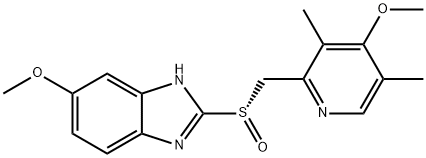Esomeprazole

|
- ₹0
- Product name: Esomeprazole
- CAS: 119141-88-7
- MF: C17H19N3O3S
- MW: 345.42
- EINECS:643-098-6
- MDL Number:MFCD09907604
- Synonyms:EsoMeprazole EC Pellets 22%;EsoMaprozole;1H-BenziMidazole,6-Methoxy-2-[(S)-[(4-Methoxy-3,5-diMethyl-2-pyridinyl)Methyl]sulfinyl]-;EsoMeprazole EC Pellets 8.5%;6-Methoxy-2-{(S)-[(4-Methoxy-3,5-diMethyl-2-pyridinyl)Methyl]sulfinyl}-1H-benziMidazole;Esomeprazole(Na、Mg);(5-methoxy-1H-benzimidazol-2-yl)[(4-methoxy-3,5-dimethylpyridin-2-yl)methyl]sulfoniumolate;(S)-Esomeprazole
| Manufacturer | Product number | Product description | Packaging | Price | Updated | Buy |
|---|
Properties
alpha :D20 -155° (c = 0.5 in chloroform)
Boiling point :600.0±60.0 °C(Predicted)
Density :1.37±0.1 g/cm3(Predicted)
storage temp. :Sealed in dry,Room Temperature
solubility :DMF: 30 mg/ml,DMSO: 20 mg/ml,Ethanol: 10 mg/ml,PBS (pH 7.2): 10 mg/ml
form :A solid
pka :8.50±0.10(Predicted)
CAS DataBase Reference :119141-88-7(CAS DataBase Reference)
Boiling point :600.0±60.0 °C(Predicted)
Density :1.37±0.1 g/cm3(Predicted)
storage temp. :Sealed in dry,Room Temperature
solubility :DMF: 30 mg/ml,DMSO: 20 mg/ml,Ethanol: 10 mg/ml,PBS (pH 7.2): 10 mg/ml
form :A solid
pka :8.50±0.10(Predicted)
CAS DataBase Reference :119141-88-7(CAS DataBase Reference)
Safety Information
| Symbol(GHS): |

|
||||||||||||||||||||||||||||||||||||||||||
|---|---|---|---|---|---|---|---|---|---|---|---|---|---|---|---|---|---|---|---|---|---|---|---|---|---|---|---|---|---|---|---|---|---|---|---|---|---|---|---|---|---|---|---|
| Signal word: | Warning | ||||||||||||||||||||||||||||||||||||||||||
| Hazard statements: |
|
||||||||||||||||||||||||||||||||||||||||||
| Precautionary statements: |
|
Description
Esomeprazole, formulated as a magnesium salt, reached the market as a treatment for acid-related diseases such as gastro-esophageal reflux (GERD) disease including peptic ulcer disease and reflux esophagitis. Esomeprazole (formerly perprazole) is the active (S)- enantiomer of omeprazole (1988) and the first proton pump inhibitor developed as an optical isomer. It can be obtained by several routes such as asymmetric oxidation of the pro-chiral pyridylmethyl benzimidazole sulfide, separation from the racemic sulfoxide by chiral chromatography or separation of a diastereomeric mixture obtained from the racemic compound and a chiral acid, followed by hydrolysis. Biochemical studies have shown that esomeprazole irreversibly inhibits the gastric H+/K+-adenosine triphosphatase (ATPase), an enzyme system involved at the secretory surface of the stomach’s parietal cells responsible for the secretion of gastric acid. Compared with racemic omeprazole in healthy subjects, esomeprazole has higher bioavailability, is absorbed more rapidly and exhibits a more uniform and predictable dose-response with higher plasma levels, leading to less inter-individual variability between slow and rapid metabolizers. In extensive clinical trials in patients suffering from GERD symptoms, esomeprazole provided superior acid control and significantly reduced the healing time compared to omeprazole.More related product prices
Dimethyl fumarate Dimethyl sulfoxide Dimethyl disulfide Dacthal Benzimidazole (Trifluoromethoxy)benzene 2,6-Lutidine Dimethyl ether Omeprazole Dimethyl sulfate Phenformin Dimethyl carbonate ETHANE N,N-Dimethylformamide Esomeprazole Lansoprazole Pantoprazole R-(+)-LansoprazoleRelated product price
- Dimethyl fumarate
₹1859-9800 - Dimethyl sulfoxide
₹802.14-1456730.01 - Dimethyl disulfide
₹2412-62249.99






